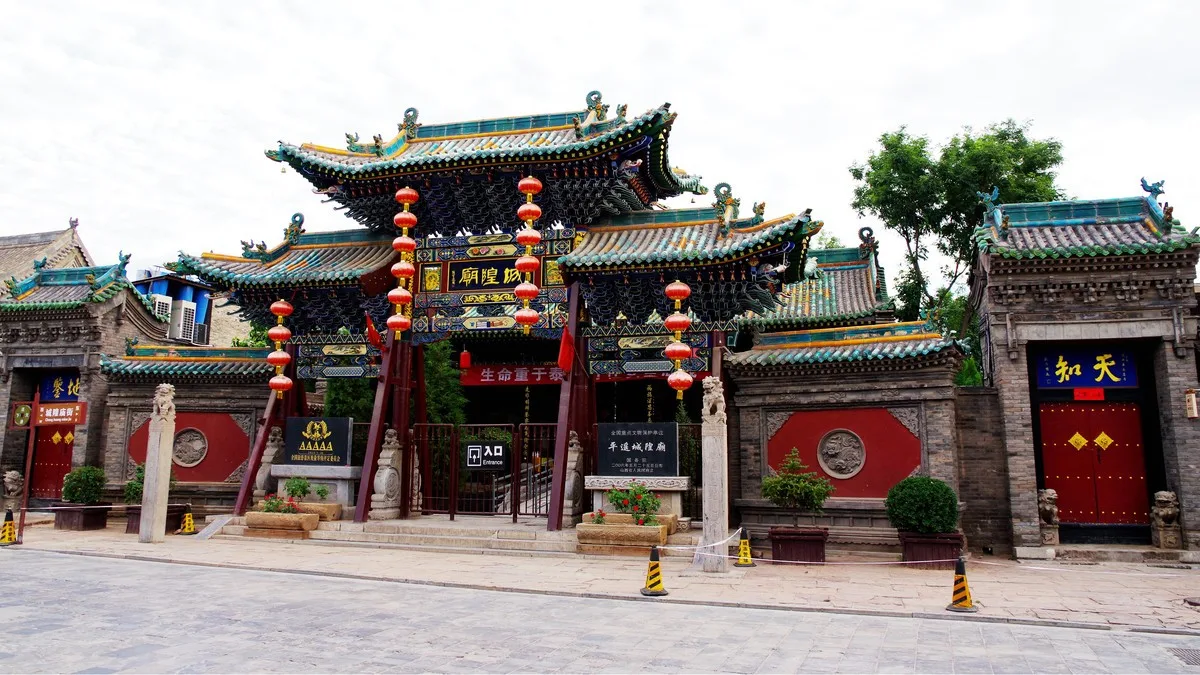The City God Temple in Pingyao (平遥城隍庙, Chenghuangmiao) is a prominent historical and cultural site located in the central section of Chenghuangmiao Street, Pingyao County. Spanning a total area of 7,302 square meters, the temple’s origins are unknown, but it underwent significant renovations during the Ming and Qing dynasties. The temple complex is aligned along a north-south axis and features three courtyards, including an archway, the main gate, an opera stage, the Offering Hall, the City God Hall, and the sleeping palace. Additionally, the temple houses the Six Departments, the Earth God Shrine, the God of Wealth Temple, and the Kitchen God Temple.
Table of Contents
- Basic Information
- Location and Transportation
- Layout of the City God Temple
- Other Attractions in Pingyao Ancient City
Basic Information
| Estimated Length of Tour | 30 minutes |
| Ticket Price | Included in the ticket for Pingyao Ancient Town |
| Opening Hours | 8.00 – 17.30 |
| Telephone Number | 0086-0354-5690000 |
Location and Transportation
The City God Temple is located at No. 51 Chenghuangmiao Street, Pingyao County, Jinzhong City, Shanxi Province. To get there, you can take bus Pingyao 102 or Pingyao 108 (North Line) and get off at the Great South Gate (Da Nanmen) stop. From there, it is a short walk to the temple.
Layout of the City God Temple
Opera Stage (戏台)
Also known as the Music Pavilion or Dance Pavilion, the opera stage is designed with a double-eaved Xieshan-style roof and a veranda structure, spanning three rooms with a glazed tile roof. Plaques hang on both the front and back of the stage, with the northern plaque reading “Zhaoge Tower” and the southern one “Ganru.” The stage’s acoustics are enhanced by ten large clay jars buried beneath the stage floor, creating a multi-chamber resonance area. The ceiling above the stage is constructed as a wooden resonance box, which, combined with the echo handling of the Offering Hall and the main hall, forms a comprehensive resonance system.
Offering Hall (献殿)
The Offering Hall is five rooms wide with a gabled roof and features a Xieshan-style veranda at the front. The hall’s walls are open, allowing for transparency. In front of the hall is a stone-pillar and balustrade terrace, with a single-step platform at the front. The main hall, or City God Hall, is five rooms wide with a Xieshan-style veranda in the center. The hall’s roof is covered with yellow glazed tiles with green trim, and the eaves are decorated with He-xi-style paintings. Inside the main hall stands a statue of the City God, flanked by statues of small ghosts and judges. The west wall of the main hall features a mural depicting the City God on tour, painted using the traditional Bai Miao technique. The hall’s roof crest features a gourd-shaped ornament, a symbol of northern Taoism.
Six Departments Hall (六曹府)
Located in the eastern side hall, the Six Departments Hall contains statues of judges from the six departments, as well as various figures from the underworld, such as the Black and White Impermanence. These statues are created using traditional painted sculpture techniques.
Earth God Shrine (土地祠)
The Earth God Shrine is located in the western side hall and contains statues of the 40 Earth Gods from the 40 neighborhoods of Pingyao during the Ming and Qing dynasties. Some of these statues are standing while others are seated.
Sleeping Palace (寝宫)
The Sleeping Palace features a roof crest with a blue and white porcelain base topped with a 1.7-meter-high gourd, which consists of one blue and one green sphere of different sizes stacked on top of each other. This gourd serves as a Taoist symbol. The sleeping palace is the resting place of the City God, constructed as a building with an upper pavilion and a lower cave. The lower cave houses the main statue of the City God, flanked by judges of life and death and of good and evil. The upper pavilion contains statues of the City God and his wife, accompanied by boy and girl attendants.














